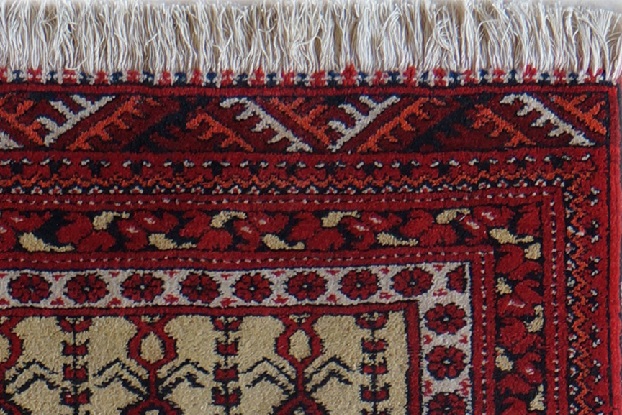
“No one is allowed to use the conference room anymore,” my manager at the environmental lab explained during a brief encounter in the hallway, “Unless it’s for prayer.”
A few of us lab analysts had a habit of stowing our bags in the conference room during the overnight shift while others could be found snoring through their lunch breaks. On one of the shelves, next to a stack of SOP binders, was a Persian rug neatly folded with the sign, Prayer Session, on top. On three occasions, I had walked in on three different coworkers in the midst of their salah, prostrated on the rug, as I tiptoed around to grab my bag, all the while apologizing in whispers.
One coworker was a fellow Indian American — a hijabi. The other two were cousins from Egypt. While it was comforting and refreshing to see religious tolerance in a time of widespread Islamophobia, I began to wonder if that last part was snuck in because I seemed to match a certain profile. Would she have mentioned the prayer exception to a coworker who was black and happened to be Pentecostal? Or perhaps to the technician who was Chinese and could be Buddhist? After all, prayer transcends both nationality and color.
“After all, prayer transcends both nationality and color.”
This incident made me consider how melanin, a dark brown polymer, antioxidant, and food additive, blurs my identity with that of so many others. In the current political climate, with hateful rhetoric spewed during our national debates (by the likes of Donald Trump), brownness is seen as an invasive threat. I could easily be lumped in with Arabs under the umbrella of Islam, and be perceived a potential terrorist. In December, in Michigan, a Sikh store clerk was shot in the face by a gunman after being accused as such. Another Sikh, a seventh grader, was recently held in juvenile detention for three days due to a hoax bomb threat.
The irresponsible fear mongering of politicians and certain media outlets not only threatens the safety of Muslims and other cultural/religious groups, but also conflates them into an indistinct conglomerate, at once dehumanizing and criminalizing all of them for the actions of a few, unrepresentative, barbaric outliers. Even with Muslims and other allies denouncing Daesh, anti-Islamic sentiment is spilling out across the nation.
As a St. Thomas Nasrani, I have been relatively sheltered. Unlike my Hindu and Sikh peers, for example, I enjoy a certain benefit when asked about my identity because Christianity is generally well regarded by most Americans. Even Kerala-specific traditions can be explained against a familiar Judeo-Christian context.
“You’re Christian?!” exclaimed one coworker, with the same excited gleam of countless faces before.
“Yes,” I respond. An invisible barrier dissipates.
Truth be told, some people seem to find me much more approachable after that. By virtue of my faith in Jesus, I am primed to be more accepted, thus sparing me from complete marginalization as a foreigner.
Perhaps the most obvious aspect of this phenomenon is my name. Ansel, with its Yiddish and Germanic roots, is a far cry from the polarizing Muhammad, or the perplexing Krishnachandra, even though it is no less phonetic. As one Polish manager was quick to note, “Your name sounds Jewish!”
But this benefit only exists when the other party knows my religious identity. As a child, I trudged three blocks every Sunday for the Malankara Orthodox Syrian mass in the basement of a multicultural Lutheran church. And towards the end of the trek, I would ignore the Jewish man next door as he spat out his window at saree-clad aunties, snarling, “Dirty f***ing Hindus.”
Whether we were Hindus or Jains, or he was targeting Sikhs or Parsis, the inhumanity, the hurt — it all fell the same in rabid saliva.
“Only through interaction, can those who seem foreign become familiar.”
Today, I attend Orthodox mass in the annex of an Episcopal church. As our hymns die down for the sermon, their melodious organ wafts in through the adjoining walls. Every November, we share a Thanksgiving feast and on Palm Sunday, we circle the neighborhood together, holding palm fronds, tossing rose petals as both Malayalam and English intertwine in the air.
Whereas these events are fleeting, the respect that is forged is not; two congregations become enriched, aware and mutually receptive. In turn, an individual who is now aware of Malayalis by extension may be more accepting of Pashtuns, illustrating in a sense, a human form of Batesian mimicry. Only through interaction, can those who seem foreign become familiar. And once we realize that all people are uncannily similar, we can start to support a diverse human ecology of symbiosis.
Since my manager’s decree, employees have been eerily absent from the conference room, although every now and then, a rebel sneaks in to catch some sleep. As I pass by the closed door, I wonder each time if it is empty or if someone indeed is praying inside. Although I never enter, I still pray out of habit, quietly to myself, that someday, we can look beyond that dark brown polymer found in all of us.
* * *
Ansel Oommen is a freelance writer, artist, and citizen scientist residing in Queens, New York. Discover more at: https://www.behance.net/Ansel.












